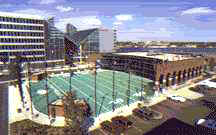|
| |
Back
to Articles Menu
College Football Hall of Fame Belongs in South Bend, not Atlanta
by
Randy Snow
Originally
posted on AmericanChronicle.com, Friday, October 2, 2009
On September 22, the National Football Foundation
announced that the College Football Hall of Fame, which is currently located in
South Bend, Indiana, would be moving to Atlanta sometime in 2012. The South Bend
location is not drawing the kind of numbers that the foundation expected, so
this move is all about money. But sometimes, it should be about what is right,
rather than what is the most profitable.
 In
my opinion, South Bend is the perfect location for the Hall of Fame. There is no
other city in the country that can boast the kind of college football history
and tradition that South Bend has. The Hall has been in South Bend since 1995
after moving from Kings Mills, Ohio. It is a wonderful place to visit and to
learn about the great players and events that have made college football the
spectacle that it is today. In
my opinion, South Bend is the perfect location for the Hall of Fame. There is no
other city in the country that can boast the kind of college football history
and tradition that South Bend has. The Hall has been in South Bend since 1995
after moving from Kings Mills, Ohio. It is a wonderful place to visit and to
learn about the great players and events that have made college football the
spectacle that it is today.
The
football legacy in South Bend began with legendary Notre Dame coach Knute Rockne,
who first came to national attention as a player for the Fighting Irish. The
forward pass was added to the college football playbook in 1906, but many
schools were reluctant to use it and preferred to continue to emphasize the
running game. But Notre Dame Coach Jesse Harper believed in the forward pass and
integrated it into his game plan. As a end/receiver, Rockne and quarterback Gus
Dorais shocked the college football world when the Irish traveled to West Point
and beat a powerful Army team 35-13 in 1913 with a newly perfected passing
attack, the likes of which had not been seen on the east coast up to that time.
Rockne became the head coach at Notre Dame in 1918 and remained at the school
through 1930, posting an unbelievable record of 105-12-5. Rockne was killed in a
plane crash in 1931 at the age of 43 and is buried in a cemetery in South Bend.
From 1918-1920, a young man by the name of George Gipp, a.k.a, "The Gipper,"
became a star at Notre Dame also, and was the first All-American ever at the
school. Then in 1924, a Fighting Irish backfield known as "The Four Horsemen"
led the team to its first national championship.
Beyond South Bend, several other teams in the
Midwest helped to establish the region as the cradle of early college football.
The University of Chicago is where legendary coach Amos Alonzo Stagg made a name
for himself. The Galloping Ghost (Red Grange) and Coach Bob Zuppke put the
University of Illinois on the map in the 1920īs and it was the vision of
Fielding Yost at Michigan that produced a one-of-a-kind stadium in 1927 that
simply became known as "The Big House."
The city of South Bend has embraced the Hall of Fame and held an annual Fan Fest
that included, among other things, a huge parade through the downtown streets
featuring the current class of inductees.
You may not be a fan of the Fighting Irish, but you cannot deny their place in
college football history. From Touchdown Jesus to the Golden Dome, from Knute
Rockne to George Gipp and The Four Horsemen, Notre Dame and the city of South
Bend are synonymous with college football. Can Atlanta make such a claim?
Should the NFL move the Pro Football Hall of Fame out of Canton simply because
it might make more money in an NFL city? Of course not. The College Football
Hall of Fame should remain in South Bend. That is where it belongs.
The lease on the building that currently houses the Hall of Fame in South Bend
expires on December 31, 2010, but it is believed that the Hall will be closed
long before that. If you have not been to see the Hall in South Bend before, I
suggest you visit it while you still can.
So to you, Atlanta, I hope you appreciate what you are getting. You now have the
responsibility to preserve the story of college football and the men who made it
what it is today. More people may come to see the Hall of Fame in Atlanta, but
many of the greatest figures in college football history have their roots in
South Bend.
Back
to Articles Menu
|
